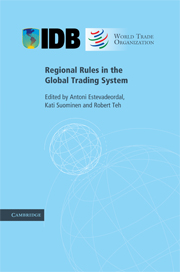Book contents
- Frontmatter
- Contents
- List of figures
- List of tables
- List of Contributors
- Foreword
- Acknowledgements
- List of abbreviations
- 1 Introduction
- 2 Big-Think Regionalism: a critical survey
- 3 Market access provisions in regional trade agreements
- 4 Trade remedy provisions in regional trade agreements
- 5 A mapping of regional rules on technical barriers to trade
- 6 Services liberalization in the new generation of preferential trade agreements: how much further than the GATS?
- 7 Mapping investment provisions in regional trade agreements: towards an international investment regime?
- 8 Competition provisions in regional trade agreements
- Appendix: List of RTAs included in the survey
- Index
3 - Market access provisions in regional trade agreements
Published online by Cambridge University Press: 01 March 2011
- Frontmatter
- Contents
- List of figures
- List of tables
- List of Contributors
- Foreword
- Acknowledgements
- List of abbreviations
- 1 Introduction
- 2 Big-Think Regionalism: a critical survey
- 3 Market access provisions in regional trade agreements
- 4 Trade remedy provisions in regional trade agreements
- 5 A mapping of regional rules on technical barriers to trade
- 6 Services liberalization in the new generation of preferential trade agreements: how much further than the GATS?
- 7 Mapping investment provisions in regional trade agreements: towards an international investment regime?
- 8 Competition provisions in regional trade agreements
- Appendix: List of RTAs included in the survey
- Index
Summary
Regional trade agreements (RTAs) have proliferated over the past decade around the world to cover nearly half of global trade. The number of RTAs notified to the WTO is approaching 200, while the total number of RTAs around the world exceeds 300. The global RTA spree has forged a veritable spaghetti bowl of multiple and often overlapping agreements. The various rules included in each RTA entangle the bowl further. Besides market access of goods, many RTAs today include provisions in such trade disciplines as services, investment, standards, intellectual property, and competition rules, as well as a host of issues not directly related to trade, such as the environment.
While RTAs can generate important economic benefits, their spread has also produced a number of concerns. First, the manifold disciplines embedded in RTAs can introduce policy frictions that increase the costs of trading. Each new RTA rule represents a new policy for firms to consider in their export, outsourcing and investment decisions. Each also has legal, administrative and economic implications to the RTA parties.
Secondly, differences in rules across RTAs can translate into transaction costs to countries operating on two or more RTA fronts simultaneously. This is a growing consideration today given that nearly all WTO members are party to at least one RTA; in some regions such as Latin America, the average number of RTA memberships per country rises to more than half a dozen.
- Type
- Chapter
- Information
- Regional Rules in the Global Trading System , pp. 96 - 165Publisher: Cambridge University PressPrint publication year: 2009
- 1
- Cited by



